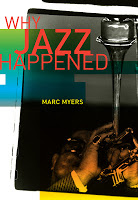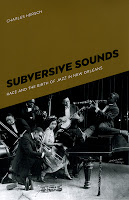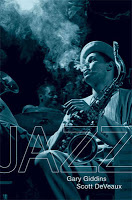Why Jazz Happened (M)
by Marc Myers
 The first comprehensive social history of jazz.
The first comprehensive social history of jazz.
It provides an intimate and compelling look at the many forces that shaped this most American of art forms and the many influences that gave rise to jazz’s post-war styles.
“Myers (who writes at The Wall Street Journal and blogs daily at Jazzwax.com) provides a needed historical overview of not only the chronological turning points in jazz history but also the societal contexts in which those events were made more likely to occur and thrive. Myers is most convincing when he focuses on technological advances such as the advent of the long-playing record album, which facilitated the typical length of the improvisationally based modern jazz that had previously been truncated by the time limits of earlier recording methods. Also of interest are discussions of the intricacies of the recording bans enforced by the musicians union, the urbanization of Los Angeles, and the civil rights movement. Myers presents his argument of “why jazz happened” in a concise, powerfully convincing style, making this book a welcome addition to the literature on the genre’s history. Summing Up: Highly recommended.” – Choice
Subversive Sounds : race and the birth of jazz in New Orleans (M)
by Charles Hersch
 “Hersch’s book is not so much about jazz music per se as it is about the circumstances under which jazz developed in New Orleans. Race was a crucial and substantial part of those circumstances, and it was by no means a simple question of black and white. Creoles were among the most important musicians in New Orleans in the early part of the 20th century, and their influence on the development of the music was considerable. Social class was another, although related, issue. But Hersch (political science, Cleveland State Univ.) clearly comes down on the side of the African American “ratty” elements as being those that defined early jazz. Although there can never be definitive answers as to how jazz came to be, Hersch cites a large number of contemporary sources, presenting a wide range of viewpoints about much of this early development. Toward the end of the book he presents Jelly Roll Morton, Nick LaRocca (of the Original Dixieland Jazz Band), and Louis Armstrong as case studies in jazz’s dissemination. This is an important contribution to the social history of New Orleans and jazz.”- Choice
“Hersch’s book is not so much about jazz music per se as it is about the circumstances under which jazz developed in New Orleans. Race was a crucial and substantial part of those circumstances, and it was by no means a simple question of black and white. Creoles were among the most important musicians in New Orleans in the early part of the 20th century, and their influence on the development of the music was considerable. Social class was another, although related, issue. But Hersch (political science, Cleveland State Univ.) clearly comes down on the side of the African American “ratty” elements as being those that defined early jazz. Although there can never be definitive answers as to how jazz came to be, Hersch cites a large number of contemporary sources, presenting a wide range of viewpoints about much of this early development. Toward the end of the book he presents Jelly Roll Morton, Nick LaRocca (of the Original Dixieland Jazz Band), and Louis Armstrong as case studies in jazz’s dissemination. This is an important contribution to the social history of New Orleans and jazz.”- Choice
Jazz (M)
by Gary Giddins & Scott DeVeaux
 “This is the story of jazz as it has never been told before: from the inside out. In this vivid history of jazz, a respected critic and a leading scholar capture the excitement of America’s unique music with intellectual bite, unprecedented insight and the passion of enthusiastic fans. They explain what jazz is, where it came from and who created it and why, all within the broader context of American life and culture. From ragtime and blues to the international craze for swing, from the heated protests of the avant garde to the radical diversity of today’s artists, “Jazz” describes the travails and triumphs of musical innovators struggling for work, respect and cultural acceptance set against the backdrop of history, commerce and politics. With photographs by Herman Leonard, “Jazz” is also an arresting visual history.” – publisher
“This is the story of jazz as it has never been told before: from the inside out. In this vivid history of jazz, a respected critic and a leading scholar capture the excitement of America’s unique music with intellectual bite, unprecedented insight and the passion of enthusiastic fans. They explain what jazz is, where it came from and who created it and why, all within the broader context of American life and culture. From ragtime and blues to the international craze for swing, from the heated protests of the avant garde to the radical diversity of today’s artists, “Jazz” describes the travails and triumphs of musical innovators struggling for work, respect and cultural acceptance set against the backdrop of history, commerce and politics. With photographs by Herman Leonard, “Jazz” is also an arresting visual history.” – publisher


